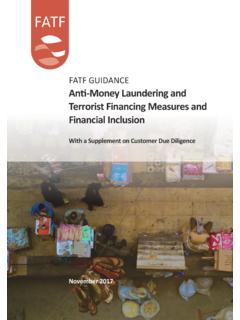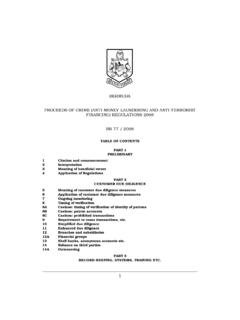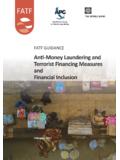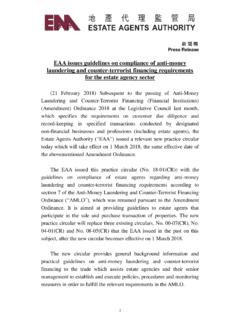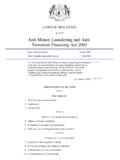Transcription of Lithuanian National Risk Assessment of Money Laundering ...
1 Lithuanian National Risk Assessment of Money Laundering and Terrorist financing 2015, Vilnius 2 Table of contents 1. Introduction .. 5 2. Methodology .. 7 STAGE 1 Data collection .. 8 STAGE 2 Risk identification .. 9 STAGE 3 Risk Assessment .. 10 STAGE 4 Risk response measures .. 10 STAGE 5 Risk management plan .. 11 NRA Process .. 12 Risk scoring matrix .. 13 3. Economic, geographical, political and legal environment .. 15 Economic environment .. 15 Geographical environment .. 16 Political and legal system.
2 16 4. Overview of organized crime and TF in 19 Overview of organized crime in Lithuania .. 19 Crime statistics .. 20 Overview of TF in Lithuania .. 20 5. The stakeholders .. 22 Overview on the Lithuanian ML/TF prevention system .. 22 FIU - The Financial Crime Investigation Service under the Ministry of the Interior of the Republic of Lithuania .. 22 Law Enforcement and other state authorities .. 24 Regulatory and supervisory authorities .. 24 Financial Institutions .. 26 Designated Non-Financial Businesses and Professions ( DNFBP ) .. 27 6. Information on identified ML/TF risks .
3 29 Results of the risk Assessment .. 30 Law Enforcement Authorities .. 30 Supervision and Regulatory 36 Financial 40 Non-Financial Sector .. 42 Low-priority risks .. 47 Appendix 1 Credible Sources .. 48 Appendix 2 Interviews with the stakeholders .. 50 3 Appendix 3 Questionnaires from stakeholders .. 51 Appendix 4 List of Lithuanian ML/TF risks .. 52 Appendix 5 Low Risk Watch List .. 59 4 Abbreviation Name & Detail AML/CTF Anti- Money Laundering / Counter Terrorism financing ML/TF Money Laundering / Terrorism financing NRA National Risk Assessment RBA Risk-Based Approach ML Money Laundering TF Terrorism financing FATF Financial Action Task Force EU European Union UN United Nations OFAC Office of Foreign Assets Control PEP Politically Exposed Persons STR Suspicious Transaction Report DNFBP Designated Non-Financial Businesses and Professions 5 1.
4 Introduction The goal of a large number of criminal acts is to generate a profit for the individual or group that carries out the act. Illegal arms sales, smuggling, and the activities of organised crime, including for example drug trafficking, can generate huge amounts of proceeds. Money Laundering is the processing of these criminal proceeds to disguise their illegal origin. This process is of critical importance, as it enables the criminal to enjoy these profits without jeopardising their source. The United Nations Office on Drugs and Crime (UNODC) conducted a study to determine the magnitude of illicit funds generated by drug trafficking and organised crimes and to investigate to what extent these funds are laundered.
5 The report estimates that in 2009, criminal proceeds amounted to of global GDP, with (or USD trillion) being laundered. This falls within the widely quoted estimate by the International Monetary Fund, who stated in 1998 that the aggregate size of Money Laundering in the world could be somewhere between two and five percent of the world s gross domestic product. Using 1998 statistics, these percentages would indicate that Money Laundering ranged between USD 590 billion and USD trillion. At the time, the lower figure was roughly equivalent to the value of the total output of an economy the size of Spain.
6 However, the above estimates should be treated with caution. They are intended to give an estimate of the magnitude of Money Laundering . Due to the illegal nature of the transactions, precise statistics are not available and it is therefore impossible to produce a definitive estimate of the amount of Money that is globally laundered every year. As Money Laundering is a consequence of almost all profit generating crime, it can occur practically anywhere in the world. Generally, Money launderers tend to seek out countries or sectors in which there is a low risk of detection due to weak or ineffective anti- Money Laundering programmes.
7 Because the objective of Money Laundering is to get the illegal funds back to the individual who generated them, launderers usually prefer to move funds through stable financial systems. Economies with growing or developing financial centres, but inadequate controls are particularly vulnerable as established financial centre countries implement comprehensive anti- Money Laundering regimes. Differences between National anti- Money Laundering systems will be exploited by launderers, who tend to move their networks to countries and financial systems with weak or ineffective countermeasures.
8 The possible social and political costs of Money Laundering , if left unchecked or dealt with ineffectively, are serious. Organised crime can infiltrate financial institutions, acquire control of large sectors of the economy through investment, or offer bribes to public officials and indeed Because of those threats, countries put in place measures seeking to take illegal proceeds from criminals, disclose predicate crimes, implement Money Laundering prevention measures, access and evaluate Money Laundering risks in National context. In response to mounting concern over Money Laundering , the Financial Action Task Force on Money Laundering (FATF) was established by the G-7 Summit in Paris in 1989 to develop a co-ordinated international response.
9 One of the first tasks of the FATF was to develop Recommendations, 40 in all, which set out the measures National governments should take to implement effective anti- Money 1 Text above is taken from official FATF website # 6 Laundering programmes. After the 9/11 events on 2001 FATF develops recommendations in the sphere of prevention of terrorist financing as well. Lithuania is a member of MONEYVAL. The Committee of Experts on the Evaluation of Anti- Money Laundering Measures and the financing of Terrorism - MONEYVAL is a permanent monitoring body of the Council of Europe entrusted with the task of assessing compliance with the principal international standards - FATF recommendations.
10 One of the most fundamental FATF standards is a requirement for countries to identify, assess, and understand the Money Laundering and terrorist financing risks for the country, and should take action, including designating an authority or mechanism to coordinate actions to assess risks , and apply resources, aimed at ensuring the risks are mitigated effectively. Identifying, assessing, and understanding ML/TF risks is an essential part of the implementation and development of a National anti- Money Laundering / countering the financing of terrorism (AML/CFT) regime, which includes laws, regulations, enforcement and other measures to mitigate ML/TF risks .
